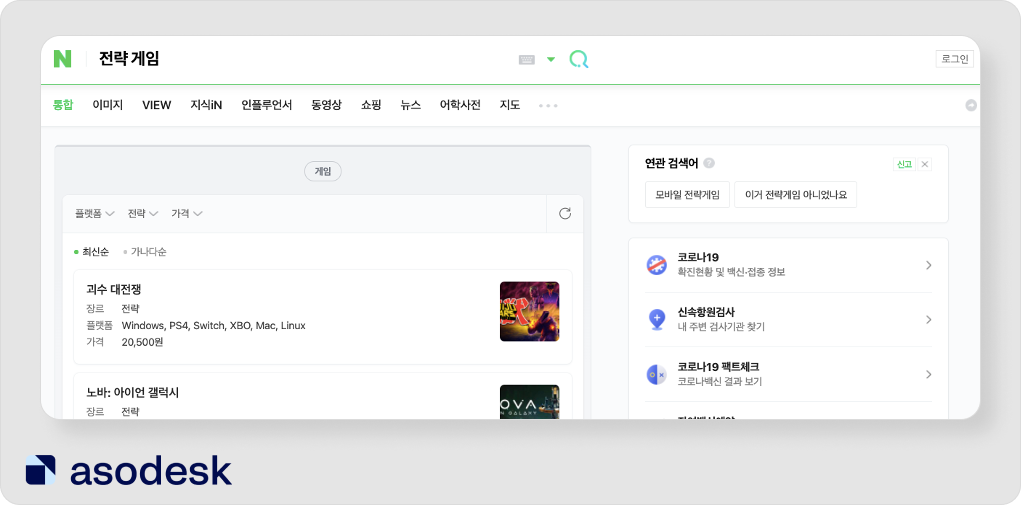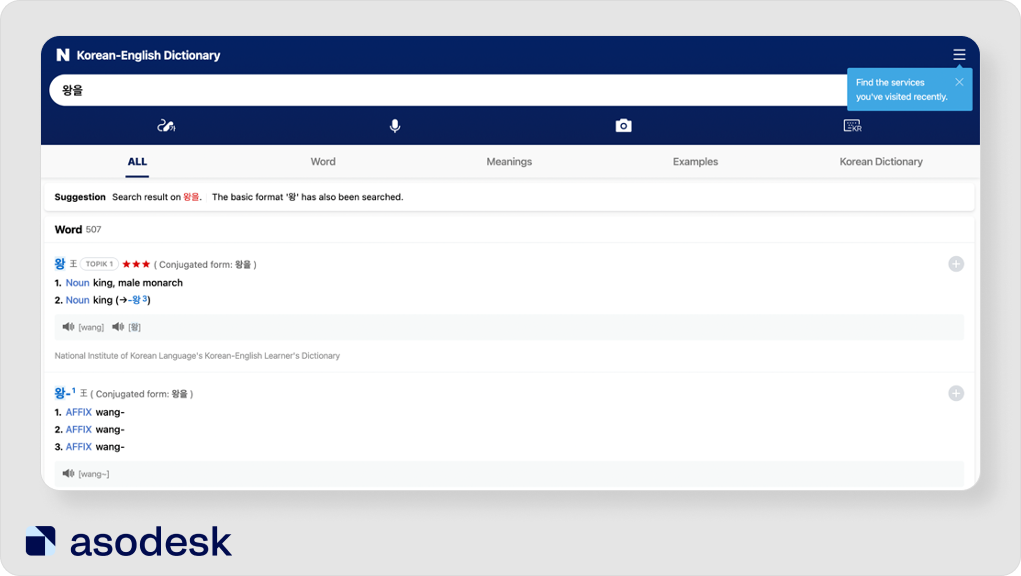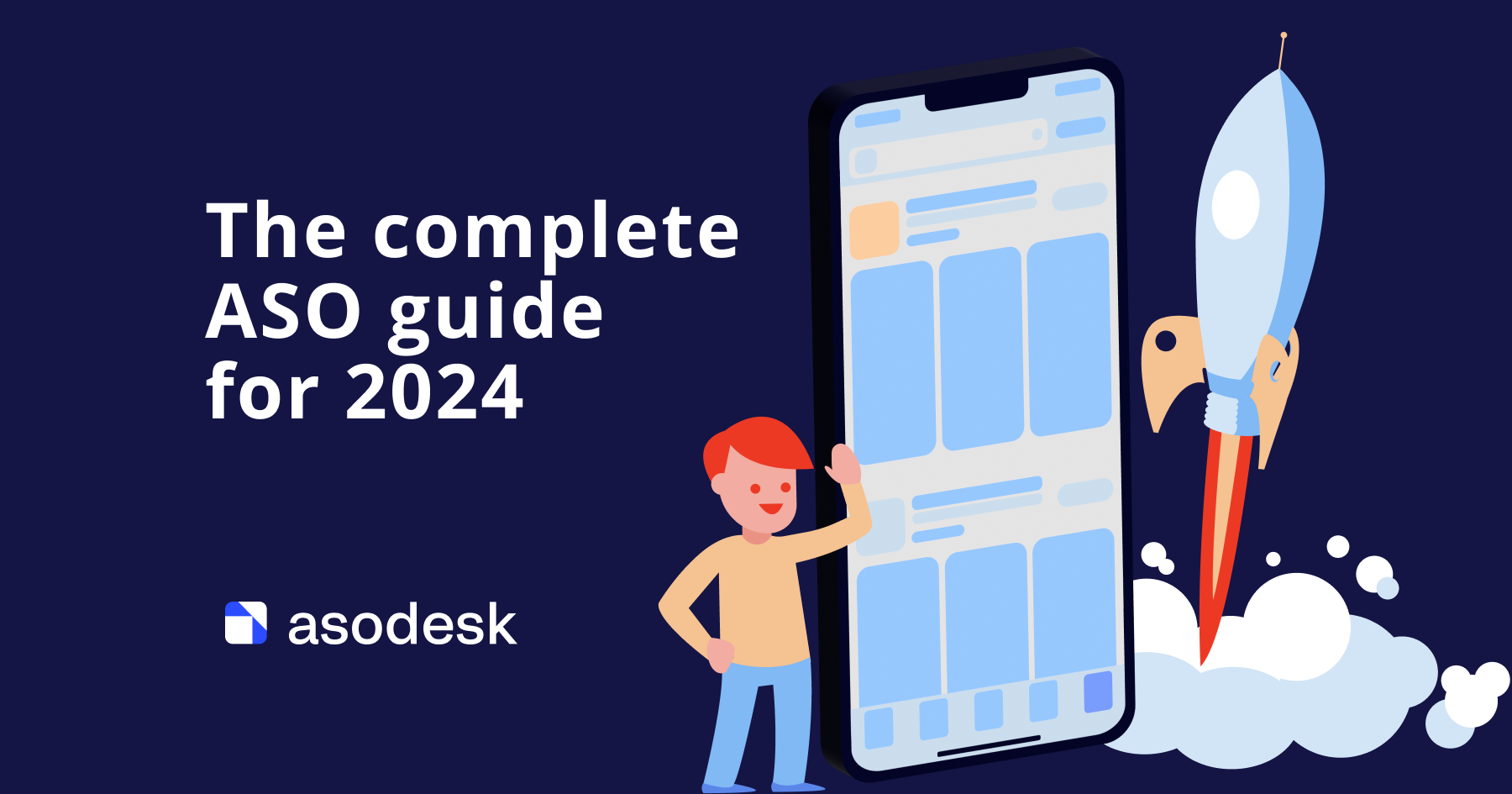How ASO specialists should localize apps for the Korean market

South Korea ranks fourth in terms of developers’ revenue, behind only China, the United States, and Japan. So, entering the Korean market can become a good point of growth and help increase the revenue for app publishers. In this article, we will explain how to localize an app’s text metadata into Korean and what important things to consider in the process.
Contents
Features of the Korean market
Features of the Korean language
Features of semantic core collection
Preparing text metadata
App page design
Checklist on ASO for the Korean market
You will learn how to search for keywords in Korean, check them for errors, and compile text metadata for the App Store and Google Play yourself. The article will not give a complete picture of all the features of the Korean language, but will give you some essential insights.
This material is from the localization cycle by Asodesk. In the previous articles, we explained how to use ASO and localization to increase an app’s audience, how to work with Eastern languages, and how to localize an app into Japanese.

Features of the Korean market
The South Korean market is dominated by Google Play (71%) and an alternative store on Android – One Store (18.4%), while only 10% of Koreans use the App Store.
Among Koreans, local app developers and international developers with strong brands are popular. If your brand is not recognized around the world, it is especially important for you to localize your app for South Korea properly.
To increase awareness of your app in Korea, you need to write reviews on dedicated portals and do integrations with bloggers and publications on game portals. You can promote on Korean platforms yourself: Naver Cafe and Naver Blog.
Features of the Korean language
For localization into Korean, we use the Seoul dialect — the official language of South Korea. The Pyongyang dialect is common in the DPRK. It is important not to confuse them when localizing, as there are differences between the dialects.
The Korean language has a number of features to remember when localizing:
1. Hangul is not hieroglyphs. Many ASO specialists believe Korean uses hieroglyphic writing, but this is not true. What seem to be hieroglyphs are letters combined into syllables. In Korean writing, the letters do not follow each other but are grouped in tiers. One syllable can contain from two to four letters: 가 (2 letters), 각 (3 letters), 갂 (4 letters). Korean writing cannot be referred to as hieroglyphs, as this is considered ignorant and insulting to native speakers.
2. Words in various noun cases often have zero Daily Impressions in Korea. According to the rules of Korean, when writing a noun, you need to choose its noun case. But noun cases are often omitted in conversation and when searching the Internet, as users tend to simplify their language to save time.
For example, users search for the word 왕 (King) in search, but in most cases, it has zero Daily Impressions:
왕 + 이 — nominative case (who?)
왕 + 을 — accusative case (whom?)
왕 + 의 — genitive case (whose?)
왕 + 에게 — dative case (to whom?)

In search queries, you will often see misspelled words. Native speakers will understand the text where you omit cases, but it will be grammatically incorrect, and errors always reduce conversion.
Therefore, words without cases are better used in the App Store keyword field, which is not visible to the user. To claim positions for words without cases on Google Play, add them to the end of the description, for example, in the form of direct speech. Users rarely open the full description and read all of it, so they may not notice the error.
You can also insert a keyword in the wrong case with high Daily Impressions using direct speech.
3. Koreans use Konglish. English words are most often used in the text to attract attention. For example, everyone knows what “fighting” is in the gaming industry, but Koreans associate it with the phrase “don’t give up”. Diet means losing weight in different ways — not just a customized eating plan. Therefore, it’s important to keep in mind that a familiar word may have a different meaning and different search results in Korea.
You might also find pseudo-English words that were invented in Japan and later spread to Korea.
Most Koreans understand words like good, cool, ok, and play. When collecting a semantic core, you can find words in both languages.
But no matter how well a foreigner knows English, they will always be partial to their native language. So, ASO specialists can pursue three possible strategies:
- Use English words for one field, for example, in the Title, and Korean words for the short description, or vice versa. It is important to focus on keywords’ Daily Impressions.
- Add Korean words to visible areas, and leave English and Korean words to the keywords.
- Add English words in parentheses after Korean words in the full description on Google Play. This is especially relevant for genre keywords.
Koreans can combine Korean and English in one word, thereby forming incomprehensible words. For example, the word 인싸 (Insa) is an abbreviation of the word insider and refers to a member of a group who is popular.
4. Koreans build sentences in a different way. The attribute (object’s description) comes first, then the subject (noun/noun phrase performing the action), the adverbial (time, place, action), then the object (object of an action), and, last of all, the predicate (action).
Let’s analyze the phrase: “I’m watching a movie”:
저는 영화를 보고 있어요
저는 (I’m) — subject;
영화를 (movie) — object;
보고 있어요 (watching) — predicate.
The subject may be omitted if it is clear who is performing the action. This will save space for other keywords. But don’t forget that the predicate is always at the end of the sentence. If there is no predicate, the subject is put at the end of the sentence, for example:
I’m a journalist -> 저는 기자입니다
In this case, the subject is followed by the linking verb 입니다 meaning “to be”. As a rule, machine translation correctly follows this order, but errors may occur when using a formal style.
In the screenshot, you can see two variations of one sentence: 나는 기자다 and 나는 언론인이다. Let’s see why this happens.

저는 is used in the meaning of “I am” (name, profession) or emphasizes that it’s me who did something. This is the formal style. 나는 means the same, only informal.
언론인 (press): 기자 (reporter) + TV 앵커 (anchor) + announcer + someone who works in this industry. In our sentence, we will use the word only in the meaning of “reporter” —기자.
Now let’s move on to the word endings: 다 is the standard ending of all verbs and adjectives in Korean. 입니다 is a linking verb with the meaning “to be” in formal speech. 이다 is the informal verb “to be”.
Analyze this example carefully. It will help you create a better short description. This way you will also understand the basic rules that will help you in the future.
5. Korean uses measure words after the numerals. Instead of “5 cats”, it is correct to say “cats 5 heads”. The measure words used for cats and for people are different.

It is important that numbers up to 100 are written in Korean numbers. From 100 — in Chinese numbers. Korea uses a 12-hour system. The hours are written in Korean numerals, while the minutes and seconds are written in Chinese. The date is written in the YYYY-MM-DD format. Sunday is considered to be the start of the week.
In text, avoid using the number 4 (it sounds like the word “death”). In South Korea, it is considered to be unlucky. You can replace it with a lucky number — 7.
For effective communication with users, it is important not only to know the language but also to understand the nuances of the country’s culture. To better understand the specifics of Korean culture for your niche, analyze competitor apps that are promoted on the Korean market. If you don’t understand something about their positioning, ask native speakers.
Features of semantic core collection
To build a semantic core for Korean, use the following plan:
1. Highlight the most effective and high-frequency keywords for your app in one language. Often, they coincide in many languages, but there are exceptions. For example, the two keys for an auto battler — “auto” and “chess” — won’t necessarily create a strong combination when translated. After selecting the most popular keys, find the most suitable synonyms and proceed with their machine translation.
2. Use auto-suggestions from an ASO service to find different keyword variations: the most popular keywords, competitor keywords, long-tail keywords, and missed keywords. Tools for collecting a semantic core will find words that are not obvious to you but are common among Koreans.
Asodesk also has a feature that automatically translates keywords from Korean into English.


Read how to find all the keywords you need with Asodesk.
3. Keep in mind that there are many synonyms and anglicisms in Korean, as well as formal and colloquial variants of words. At the stage of collecting the semantic core, do not filter out these words, otherwise, you risk missing important and popular keywords.
Don’t rush to delete words with zero Daily Impressions. Perhaps, after translating the word it had case endings. You can check the original spelling of the word in the online dictionary.
4. Having collected the semantic core, study the competitors’ positions for keywords and check if they are relevant to your app. Because you don’t speak Korean, you may mistakenly choose keywords that don’t suit your app. Therefore, it is important to focus not only on the translation of the word but also on the search results and competitors.
View the search results for all keywords from the semantic core using Keyword Chart in Asodesk.

5. Do not use automatic translation exclusively. It is not enough to verify keywords with Google Translate. In my experience, Google Translate sometimes translates the words as abbreviations, unfinished words, or with errors.
The artificial intelligence of translation services will almost always give a correct translation of a word with an error in your language. Therefore, you should send the compiled semantic core to a native speaker for verification.
Thus, the collection of the semantic core for Korea is similar to other countries, but it is important to consider the nuances of Korean.
Read more on how to build a semantic core for any country.
Preparing text metadata
Selecting keywords for Title and Subtitle
Often, ASO specialists compile metadata in their own language first and then translate it into Korean. In European languages, keywords take up more space and there are not many characters left for additional keywords. However, after translating words into Korean, you can notice that there is still some room left. After that, you can start adding other keywords, but the meaning will already be distorted.
Therefore, it is better to generate the Title from scratch from keywords that were selected for the semantic core. And then send them to a native speaker for proofreading, indicating that the text length should not exceed 30 characters. The same goes for Subtitles.
Selecting keywords for the short description
I will explain how to select keywords for a short description using an RTS game as an example:
캐슬 — castle
공성전 — siege
택틱스 — tactics
전술 — tactics
As you can see, the service offered two variations of the same word. The first variation of “tactics” is an anglicism, the second is originally Korean. Anglicisms are slightly more common in games than in other apps.
킹덤 — kingdom
킹덤디펜스 — kingdom defense
방어 — defense
The first case probably describes the name of the game, and the second case can be about a skill. As I mentioned above, you can use anglicisms in titles, mission names, skills, and characteristics. But in descriptions, you should give preference to original Korean words.
In addition, “kingdom defense” is written as one word. According to the rules, two words should be separated with a space (킹덤 디펜스). Koreans like to write short sentences without spaces to save time. That is why you can often find merged spellings of words in search queries.
정복 — conquer
전략 — strategy
전략게임 — strategy game
전략 게임 — strategy game
The same goes for “strategy game” — the second variation is its correct spelling. Therefore, you shouldn’t avoid spaces in Korean like in Japanese. Remember to use them in a grammatically correct way.
Compiling the description
Although many users don’t read the long description in the games, on Android it is better to stick to Hangul — the official writing system of the Korean language. Korean people will definitely understand your description, and you will be able to use more keywords that are popular in South Korea. What’s more, Hangul helps save space — when translated from English, the text becomes shorter.
You can check the correctness of the sentence using Naver, a Korean search engine. Also, when searching, there will be “related queries” on the right. This approach will help increase the number of potential keys, but it is important to check their frequency for mobile apps.
When selecting the Title, Subtitle, and Short Description, you can simply get a native speaker from any language exchange site to proofread them. But when writing a full description, it is better to contact a professional who will be able to adapt the text to the culture of the country.
But you should tell them in advance that you need formal Korean, not colloquial Korean. In one of the texts, I deliberately omitted cases, but several native speakers said that there were no errors in the text.
If you are a novice developer and do not have a budget for a translator, you can try automatic translation. To do this, create a simplified version of the text in your native language with no complex structures, ambiguous expressions, or slang. In the source text, insert keywords that will become the necessary keys in Korean when translated. Translate via Google Translate and check the correctness of the translation based on the checklist at the end of this section.

Let’s see how to select keywords for the description using a game as an example. We have the following description:
Defend your castle from a siege by your enemies. Adopt war tactics. And conquer the kingdom in a real-time online strategy game.
Using Google Translate, we translate this text into Korean. We get 64 characters. We add new keywords to the text. Now we have 75 characters out of 80:
원수에 의해 포위 공격에서 성을 방어. 전쟁 전술을 채택하십시오. 그리고 실시간 온라인 전략 게임에서 왕국을 정복. 군인과 궁수 준비했습니까?
Check the text for correct keyword translation. For example, we have 왕국을 (kingdom), but we need a different variation of this word — 킹덤. In this case, we replace the word and add the ending of the accusative case: 을 or 를, depending on whether the syllable ends with a consonant or vowel. In the word 킹덤 (kingdom) ㅁ is a consonant, so we add 을; if it wasn’t there, we would use 를.
After correcting the text, we send it to a native speaker. Make sure that the text does not exceed 80 characters and add a short description to Google Play:
적의 포위 공격으로부터 성을 방어하세요. 전쟁 전술을 선택하세요. 그리고 실시간 온라인 전략 게임에서 킹덤을 정복하세요. 궁수는 준비됐나요?
Let’s compare each sentence to understand what has changed:
원수에 의해 포위 공격에서 성을 방어 -> 원수에 의해 적의 포위 공격에서+으로부터 성을 (castle) 방어+하세요 (defense)
전쟁 전술을 채택하십시오 -> 전쟁 (war) 전술을 (tactics) 선택하십시오+세요
그리고 실시간 온라인 전략 게임에서 왕국을 정복 -> 그리고 실시간 온라인 전략 게임에서 + 왕국을 킹덤을 (kingdom) 정복+하세요 (conquer)
군인과 궁수 준비했습니까 -> 군인과 궁+수는 준비했습니까+됐나요
Without knowing the language, it is impossible to check the correctness of the text on your own. But you can register on a language exchange site. If you have doubts about a piece of text, you can ask other users for help.
Also, instead of Google Translate, it is better to use its Korean alternative. When you use a translator and want to understand what is a word and what is a case ending, as with 을, you can check the noun in an online dictionary. 95% of the time, the dictionary will show you the original form of the word.

You should pay attention to the following common mistakes of machine translation:
1. “Bare” nouns at the end of the sentence. You need to add a polite ending 입니다 to such nouns. If it’s a question, use 입니까?
원수에 의해 포위 공격에서 성을 방어 -> 원수에 (enemies) 의해 포위 공격에서 성을 (castle) 방어+입니다 (defend)
Defend your castle from siege by enemies
2. In the imperative mood, 십시오 is used instead of 세요, but 십시오 sounds a little rude.
왕국 건설하십시오 -> 왕국 (kingdom) 건설하십시오+세요 (build)
Build a Kingdom
The form 십시오 can be used in the game when one character gives an order to another character or the player.
3. The use of the word “you” (당신). It should either be removed completely (since impersonal sentences are common for Korean) or replaced with “dear user” (유저님)
RPG 세계의 마법사가 당신을 도울 것입니다 -> RPG 세계의 (world) 마법사가 (wizard) 당신을 유저님을 (user) 도울 것입니다
Wizards of the RPG world will help you
Now take a look at another Tower Defense game’s short description before correction:
왕국 건설하십시오. 성 방어하십시오. 그리고 적으로부터 땅을 해방시키십시오, 왕! RPG 세계의 마법사 당신을 도울 것입니다
And after correcting each sentence according to the points above:
왕국을 건설하세요. 성을 방어하세요. 그리고 적의 땅을 공격하세요, 왕! RPG 세계의 마법사가 유저님을 도울 것입니다.
Using these rules, you will gain a significant advantage over competitors who approach localization carelessly. The information above will be enough for a quick start. And with practice, you will learn to correct the text yourself.
Once you have compiled the metadata, send it to a native speaker for translation. In the requirements, be sure to specify the keywords that you want to use in the text. Don’t be scared if the description in your language exceeds the character limit. When translated into Korean, the size of the text will significantly decrease.
App page design
To properly design an app page for Korea, I recommend following these rules:
1. Do not limit yourself to a general description; list in-game characteristics as well. Korean gamers love games with leveling systems, the ability to improve characters, and collect items. You should write about this in the text metadata: “in the game, you will find” or “there are some gameplay features”.
2. Create not only the USP but also the discussed characteristic that will make people want to share your app with their friends. Friends are a strong promotion channel in Korea.
When explaining why your app is valuable, ask yourself the following questions:
- How can users describe your app?
- When and for what purposes will they use it?
- Why would they choose it over other apps?
3. Write texts in your native language, but using words and expressions from Korean culture. Try to stick to the limit, but do not try to fit the text in 30 or 80 characters. For the Title and Subtitle, I write a 40-character text in English. After the translation, its size reduces to the required limit.
4. When preparing metadata, use these simple 5 rules:
- Inspire confidence.
- Provide evidence.
- Call to action.
- Be friendly.
- Offer a “taste” of the game.
5. Create a brief individual player or app user profile. This will help you identify triggers. To do this, answer the following questions:
- What are your users’ age, gender, and field of work?
- What are their interests, hobbies, and values?
- How do they search for the apps, what do they watch, and what do they play?
You can view demographic data for someone else’s apps through Facebook Insight, and in Firebase and Google Analytics for your app.
Adjust your metadata using these rules. This way, you’ll take a fresh look at the text and get new ideas on how to improve your message to users.
Checklist on ASO for the Korean market
To succeed in South Korean mobile app market, you need a competent localization of your product. To sum up this article, here’s a simple checklist for working with ASO in Korea:
- Use the ASO service suggestions and the Korean search engine Naver to find all keyword options.
- Add different variations of one word to the semantic core to determine the most appropriate variations for metadata.
- Single out the strongest keywords in your language and translate them into Korean.
- Write the Title, Subtitle, and Short Description using these words.
- Translate keywords into Korean and check the spelling.
- Replace incorrect keywords with high-frequency keywords.
- Write the full description in your native language, but take into account the cultural nuances of Korea and important keywords.
- Improve the text using the 5 rules we mentioned above and add the discussed characteristic to increase the conversion rate of the app page.
- Adapt your text with the help of a native speaker or clarify important questions on the language exchange site.
- Start preparing a new text for the next iterations.
We hope that our article helped you better understand the basics of Korean writing and syntax, as well as how to compile text metadata in Korean for the App Store and Google Play independently. Subscribe to our newsletter and never miss news digests or helpful articles on ASO, mobile app marketing, and reviews.










